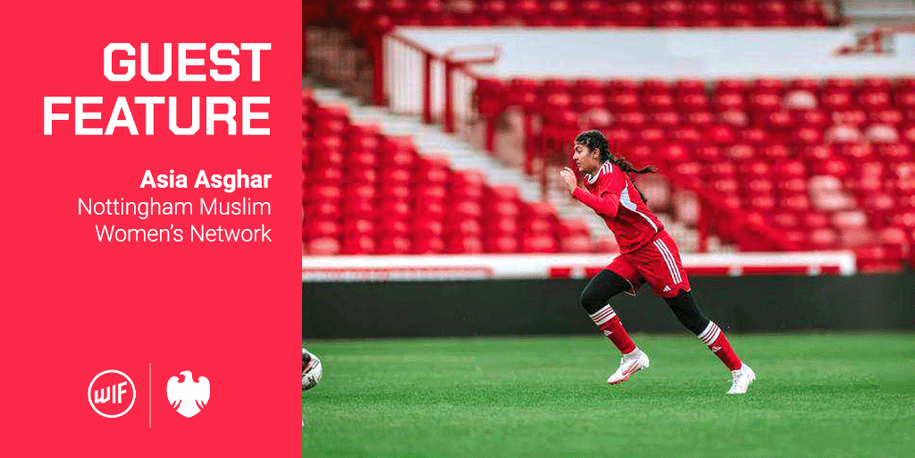News
GUEST FEATURE: SOUTH ASIAN WOMEN AND THE STEREOTYPE STRUGGLE
31 July 2024

Despite football's growing popularity among girls and women in the UK, South Asian female footballers remain conspicuously absent from the sport. This underrepresentation points to deep-rooted societal and structural barriers that continue to hinder their participation.
Stereotypes surrounding South Asian Muslim women are a significant factor in their underrepresentation in football. Cultural expectations, gender roles, and racial biases create a web of challenges that young girls must navigate to pursue the sport. As a mother and an Active Wellbeing Officer, I have witnessed these struggles first-hand through my daughter’s football career and my professional work. My daughter plays for Nottingham Forest's under-16 women’s team and is the only South Asian girl in her group. This stark reality underscores the urgent need for increased diversity and inclusion in football.
Aleeza often feels isolated on the pitch and faces immense pressure to perform as a ‘minority representative’. Despite these challenges, she remains determined and optimistic. Positive change is essential, and growing awareness within both the football industry and our communities is a crucial first step.
For my part, attending events like the Women in Football Be Inspired Conference in partnership with Barclays has given me the platform to voice my concerns and passion for change. Networking with various organisations and participating in initiatives such as the Women’s Health Summit has allowed me to express the importance of recognising and implementing faith and religious elements in the sports industry.
Acceptable pursuits
But let’s look at some of the barriers and challenges faced by South Asian women in football. Right from the start there are cultural expectations surrounding gender roles. In many South Asian communities, traditional gender roles prioritise domestic responsibilities and academic achievements over sports. Football, seen as a male-centric activity, often falls outside of those pursuits seen as acceptable for girls. This mindset limits the encouragement and support young girls receive, making it difficult to pursue football seriously.
Another issue is the perceived lack of strength or skills among South Asian women. There is a pervasive stereotype that South Asian women lack the physical prowess or athletic ability needed for football. This misconception deters girls from joining and affects their confidence and ambition.
Beyond societal stereotypes, structural barriers further hinder South Asian women from excelling in football. One is the lack of representation in the media of South Asian women in football, which perpetuates the belief that the sport is not for them. Positive media representation is crucial to challenge and change these stereotypes. More widely, an absence of visible role models compounds the issue. Without successful South Asian female footballers as role models, young girls find it harder still to see football as a viable career path.

Accessibility and infrastructure can be another constraint. Many South Asian communities, particularly in urban areas, struggle with access to facilities and opportunities. Local football clubs may not actively engage with or accommodate the needs of South Asian girls. High-quality coaching and development programmes are often inaccessible to South Asian girls. This lack of access hampers their ability to compete on an equal footing with their peers.
Then there are financial factors. Football can be costly, considering training, equipment, and travel expenses. Economic barriers disproportionately affect minority communities, including South Asians, limiting their participation.
Towards change
Despite these barriers, there is a shift towards change. At grassroots level, the FA and other organisations have launched initiatives targeting underrepresented groups. Programmes designed for South Asian girls focus on breaking cultural barriers and creating a welcoming environment.
Furthermore, through my work, I have been able to raise awareness and set up unique football sessions for the female Muslim community. These sessions have seen great interest and demand, leading us to collaborate with local clubs to establish more opportunities. My daughter and I have been actively promoting football, such as during International Women's Day, where we held an event at Trent Bridge cricket ground with local sports role models and trailblazers, including Aleeza Asghar.
Events like these provide excellent opportunities to engage with communities and spread the message that football is for everyone. Having role models like Aleeza on the panel gives the community hope and inspiration, showing them that they too can participate in football.
As well as community engagement programmes of this kind, other measures can help to break down the barriers and make football a more inclusive environment. One is through the use of role models and ambassadors. Highlighting successful South Asian women in football, whether as players, coaches, or administrators, can inspire the next generation. Campaigns and media coverage celebrating these role models are vital.
Another positive measure would be to drive inclusion through education and advocacy. Educating communities about the benefits of sports for physical health, mental well-being, and social development is crucial. Advocacy efforts must continue to dismantle the stereotypes that hinder progress.
The underrepresentation of South Asian women in UK football is a complex issue rooted in stereotypes and structural barriers. Addressing these challenges requires a concerted effort from all stakeholders, including football associations, community leaders, and the media. By promoting inclusivity, providing opportunities, and challenging stereotypes, the football community can pave the way for South Asian women to flourish on the pitch. The beautiful game, after all, should be for everyone.
Share this article
